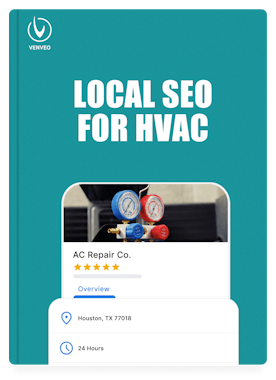The Internet is full of junk when it comes to HVAC marketing strategy.
Most articles you find on Google start by talking about stuff like making your website mobile-friendly, optimizing your website for SEO, enabling call tracking, using paid ads, managing your marketing budget, building your email list, posting on social media, etc.
But none of those things are strategy.
Those are just tactics.
And don’t get me wrong, tactics are great. But without a strategy, it’s the difference between watching high school football and the NFL.
The reason so many of the articles you’ll find on Google get this wrong is because the people writing them are junior marketers at software companies and agencies.
And it’s not their fault, either. They aren’t business owners. They haven’t learned what it takes to grow a business from nothing to 8 figures.
I do.
That’s why I’m the one writing this.
So let’s start with understanding what strategy is really all about.
The Heart of Strategy
To develop a real strategy, there are several choices you have to make:
- What does winning look like?
- Where will we compete so that we win?
- How will we compete so that we win?
- What capabilities must we have to win?
- What enabling management systems do we need to win?
Making choices about where to compete (where to play) and how to compete to win are the heart of strategy.
Where to Play
This is where you need to get clear on your target market segments and your reasoning behind it. You'll be answering critical questions like:
- Which geographic areas will we try to dominate, and which ones will we stay out of?
- Who is our ideal customer and, more importantly, who are we turning away?
- How will we reach our audience to tell them about our services?
- What's in our service lineup and what are we deliberately leaving out?
When you work through these decisions, you're essentially locking in your:
- Service area
- Target audience
- Advertising methods and mediums
- Core offerings
Example
Here’s an example of what that might look like for an HVAC business:
Service Area: We operate exclusively within a 25-mile radius of downtown Austin, Texas. We're not chasing jobs in surrounding small towns or trying to cover the entire metro area. Instead we're going deep in our core territory where we can respond quickly and build density.
Core Offerings: Premium residential HVAC replacement and high-efficiency system upgrades. We don't do commercial work, we don't touch new construction, and we're not running a 24/7 emergency repair operation. We focus on planned replacements and system optimization for homeowners who want quality over cheap fixes.
Target Audience: Homeowners in established neighborhoods with houses built between 1990-2010, household income $120K+ (top 80th percentile for Austin), who are dealing with aging systems and high energy bills. We're not serving landlords, property managers, or bargain shoppers looking for the lowest bid.
Marketing Approach: Lead generation efforts focus on Local SEO, Google Local Services Ads, Google Paid Search, and strategic partnerships with home inspectors and real estate agents. Long-term brand marketing will focus on YouTube shorts and TikTok, repurposed to Instagram Reels where possible. With a 40% allocation toward lead generation and 60% toward brand marketing so we build sustainable CAC arbitrage and can outspend competitors to gobble up more market share. We're skipping the Groupon deals, Angi leads, and broad radio advertising.
The Result: Instead of being "another HVAC company" offering any service and competing on price across three counties, we become THE go-to premium replacement specialists in central Austin's established neighborhoods.
How to Win
Choosing where you’ll compete is just the first step. Next you have to determine how you’ll win where you’ve chosen to compete.
Your objective when figuring out how to compete is simple: rig the game in your favor. Structure things so that you're playing by rules that give you massive advantages your competitors can't easily replicate.
The core question becomes: what unique value can I consistently deliver to customers in such a distinctive way that I become their only logical choice?
Don’t overthink this. There are really on two fundamental approaches:
- Win based on cost, or
- Win based on differentiation
Winning Based on Cost
Companies that choose the price war path need to be both cheaper and more profitable than their competition. They have to operate so lean that they can survive the race to the bottom while others fold.
Most of your competitors look around at what everyone else charges and base their prices off of that. But they don’t consider what kind of margins they need to sustainably stay in business and outlast the competition.
That’s why so many HVAC businesses fail in their first five years.
Brands that succeed with this approach typically leverage technology to scale beyond normal constraints. Think companies like HomeAdvisor's own services, or massive franchises with centralized systems that drive costs down through sheer volume and operational efficiency.
This is a brutal road, and we don't recommend it.
Winning Based on Differentiation
Unless you're building proprietary software or have plans to franchise at scale, differentiation is your winning play.
True differentiation means carving out a position so specific and valuable that you're genuinely unique and either too difficult or too unrewarding for others to copy.
A way I like to think about it is like this: what can I do that my competition couldn’t do even if they wanted to or wouldn’t even if they could?
So how do you actually differentiate?
It won’t be reading through marketing blog posts. I can tell you that.
Copying your competitors won’t work either (again, most of them go out of business).
The answer is simpler: talk to your customers. Have real conversations. Study what makes them tick. Pay attention to their unspoken needs. The problems they experience but can't quite articulate. Ask them how they searched for an HVAC company, why they picked up the phone to call you instead of a competitor, and what impressed them (or frustrated them) about working with you.
Keep your questions neutral. Leading questions give you garbage data.
Your customers define your market, not your competition. They have all the answers you ever need and are a goldmine of insights that most HVAC businesses completely ignore.
Tactics
Tactics are where the rubber meets the road, as the saying goes.
You've got your positioning locked in. You know where you're competing and how you're going to win. The tactics are simply how you bring that strategy to life.
There are dozens of marketing channels screaming for your attention. SEO, Google Ads, Facebook, direct mail, truck wraps, radio spots, email campaigns, referral programs, and the list goes on.
Most HVAC companies approach this backwards. They pick tactics first, then wonder why nothing works. They're on Facebook because "everyone's on Facebook." They're doing SEO because someone told them they need it. There's no coherent thread connecting it all.
If that’s you, that’s okay.
It’s not your fault. You didn’t study business but still decided to take control of your future and start one. You deserve credit for that. It takes guts and most don’t have what it takes.
But today’s the day to change how you approach things.
Your tactics should flow directly from your strategy. If you're targeting premium homeowners in established neighborhoods who are researching major purchases, your tactical mix looks completely different than if you're chasing emergency repair calls at 2 AM.
Every channel you invest in (your website, your Google presence, your truck branding, your follow-up system) should reinforce the same positioning and speak to the same customer you defined earlier.
The key isn't doing everything. It's doing the right things, consistently, until you own that space in your market.
Your Website is Your Foundation
Website Design for HVAC Businesses
Examples for inspiration. 7 sections you need. Plus a free downloadable checklist.
Read Full Guide
Your website is your central hub. Your marketing should try to get people from where they are to your website. Think of our website like Rome where all roads point toward it.
Every Google search, every truck that drives by with your number on it, every referral from a satisfied customer—they all end up in the same place: your website. It's where people go to decide if you're the real deal or just another option.
Most HVAC websites are terrible. Generic stock photos of smiling technicians. Vague promises about "quality service" and "customer satisfaction." A contact form buried three clicks deep. Zero indication of what makes them different from the ten other companies someone just Googled.
Your website needs to do one job: convert visitors into leads.
That means being crystal clear about who you serve, what you do, and why someone should choose you over the competition. No fluff. No corporate speak. Just straight answers to the questions running through a homeowner's head at 11 PM when their AC just died.
Make it fast. Make it mobile-friendly. Make it obvious how to contact you. And for the love of God, make sure it actually reflects the positioning and differentiation you spent all that time figuring out.
If your website doesn't reinforce your strategy, you're wasting every dollar you spend driving traffic to it.
Learn more in our Web Design for HVAC Guide.
HVAC Lead Generation
Lead Generation for HVAC Businesses
There are only four ways to get HVAC leads. Learn each, how to get started, and scale them.
Read Full Guide
You want leads that are engaged. That means leads that know who you are and are interested in hiring you.
You can 10x your ability to get leads by having a good lead magnet: a complete solution to a narrow problem that, when solved, reveals another problem you can solve with your paid services.
For HVAC replacement, that might be a free load calculation or rebate/financing guide. For maintenance plans, maybe a free seasonal tune-up or coil cleaning.
Then amplify it through the right channels: warm outreach (especially when you’re just getting started), cold outreach (especially if you sell B2B), paid ads, or free content on social media and your website.
Each takes different amounts of effort and time. Focus your effort into one and get really good at it before trying to add another. You can accelerate this if you hire an HVAC Marketing Agency who already knows what they’re doing, though.
Learn more in our Lead Generation for HVAC Guide.
HVAC Local SEO
Local SEO for HVAC Businesses
Local SEO for HVAC is all about optimizing the way you appear online when people go searching for the types of services you provide on Google.
Read Full Guide
When someone in your service area searches "AC repair near me" or "HVAC company [your city]," you need to show up. Not on page two. At the top.
That's what Local SEO does. It's optimizing your Google Business Profile, building local citations, getting reviews, and creating content that signals to Google: "We're the dominant HVAC company in this specific area."
This isn't about ranking nationally. It's about owning your geography. When you defined your service area earlier, Local SEO is how you become the default choice within those boundaries.
The mechanics are straightforward: claim and optimize your Google Business Profile, accumulate genuine reviews, ensure your NAP (name, address, phone) is consistent everywhere online, and create location-specific content.
Local SEO turns your website into a lead generation engine for customers actively searching in your market.
Learn more in our Local SEO for HVAC Guide.
PPC Can Bring Fast Traffic and Leads
PPC for HVAC Businesses
HVAC PPC is simple, but that doesn't mean it's easy. Clicks don't pay the bills. Customers do. Learn the fundamentals in this guide.
Read Full Guide
PPC gives you what SEO can't: instant positioning at the top of search results. The day you launch, you're visible.
But most HVAC companies waste money treating it like a slot machine—bidding on everything, writing generic ads, sending traffic to terrible landing pages.
Effective PPC requires precision. Target the exact customer you defined earlier. Bid on keywords that signal buying intent, not tire-kickers. Write ads that speak directly to their problem. And make sure your landing page delivers on whatever your ad promises.
Track everything ruthlessly: cost per click, conversion rate, cost per lead, actual revenue. Cut what doesn't work. Double down on what does.
Done right, PPC becomes a predictable lead machine. Done wrong, it's an expensive donation to Google. Learn more in our PPC for HVAC Guide.
HVAC Email Marketing
Email Marketing for HVAC Businesses
Ready-to-use HVAC email templates for seasonal campaigns, reviews, and weather alerts. Copy, customize, and start today.
Read Full Guide
Don’t sleep on email and treat it like an afterthought.
Your email list will be one of the few owned media channels you’ll have. It’ll contain your past customers, current leads, people who requested quotes, and more. It is one of your most valuable assets. These people already know you exist. They’re your warm audience. Now you need to stay relevant until they're ready to buy for the first time (or again)!
Don’t spam them with promotional offers. It's to provide value consistently so when their AC dies or they're ready to replace that aging furnace, you're the first call they make.
Send maintenance reminders. Share seasonal prep tips. Explain what that weird noise from their unit might mean. Make your emails useful, not salesy.
Email keeps you top of mind and turns one-time customers into repeat business and referrals. It's one of the highest-ROI channels available if you actually use it.
Learn more in our Email Marketing for HVAC Guide.
HVAC Social Media
Social Media for HVAC Businesses
HVAC social media post ideas and strategies that capture attention and attract new customers. 30+ examples.
Read Full Guide
Social media won't be your primary lead generator, but it plays an important role in making people aware you exist and the services you sell.
Facebook, Instagram, TikTok, and YouTube are all great platforms for advertising to your market (yes, YouTube is considered social media).
The key is consistency. Post completed installations, explain common issues homeowners face, share seasonal maintenance reminders. Respond to comments and messages promptly.
Golden Rule of Content: Respect people’s time and don’t waste it.
Think in terms of value per second, not seconds of value. If you can pack more value in less time, then do it. Ruthlessly cut the fluff out.
Different platforms serve different purposes. How you should use them will vary.
Learn more in our Social Media for HVAC Guide.
Need Help Winning Your Market?
Want to talk to people who’ve developed multiple strategies for HVAC brands over the years across dozens of different geographies?
Or what about a few extra pairs of hands to execute all the tactical work while you’re busy recruiting and hiring new techs?
Most HVAC companies waste years and tens of thousands of dollars trying to figure this out on their own. Jumping between tactics, chasing shiny objects, wondering why nothing ever seems to stick.
If you’d rather get results faster and waste less money along the way, contact us here at Venveo. We’d be glad to help.





